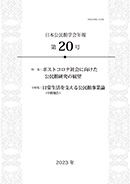最新号
選択された号の論文の13件中1~13を表示しています
- |<
- <
- 1
- >
- >|
第一部 特集 ポストコロナ社会に向けた公民館研究の展望
-
2023 年 20 巻 p. 6-9
発行日: 2023/11/30
公開日: 2024/03/28
PDF形式でダウンロード (672K) -
2023 年 20 巻 p. 10-18
発行日: 2023/11/30
公開日: 2024/03/28
PDF形式でダウンロード (898K) -
2023 年 20 巻 p. 19-25
発行日: 2023/11/30
公開日: 2024/03/28
PDF形式でダウンロード (816K) -
2023 年 20 巻 p. 26-36
発行日: 2023/11/30
公開日: 2024/03/28
PDF形式でダウンロード (924K)
第二部 小特集 日常生活を支える公民館事業論(中間報告)
-
2023 年 20 巻 p. 38-48
発行日: 2023/11/30
公開日: 2024/03/28
PDF形式でダウンロード (977K) -
2023 年 20 巻 p. 49-60
発行日: 2023/11/30
公開日: 2024/03/28
PDF形式でダウンロード (2517K)
第三部 研究論文
-
2023 年 20 巻 p. 62-72
発行日: 2023/11/30
公開日: 2024/03/28
PDF形式でダウンロード (1069K) -
2023 年 20 巻 p. 73-82
発行日: 2023/11/30
公開日: 2024/03/28
PDF形式でダウンロード (1041K)
第四部 国際交流・比較研究
-
2023 年 20 巻 p. 84-112
発行日: 2023/11/30
公開日: 2024/03/28
PDF形式でダウンロード (974K) -
2023 年 20 巻 p. 113-120
発行日: 2023/11/30
公開日: 2024/03/28
PDF形式でダウンロード (817K)
第五部 日本公民館学会第21 回研究大会記録
-
2023 年 20 巻 p. 122-140
発行日: 2023/11/30
公開日: 2024/03/28
PDF形式でダウンロード (1085K)
第六部 日本公民館学会研究活動報告
-
2023 年 20 巻 p. 142-156
発行日: 2023/11/30
公開日: 2024/03/28
PDF形式でダウンロード (900K)
第七部 公民館をめぐる動向
-
2023 年 20 巻 p. 158-183
発行日: 2023/11/30
公開日: 2024/03/28
PDF形式でダウンロード (1151K)
- |<
- <
- 1
- >
- >|
